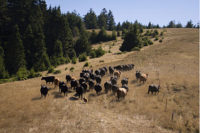As a business major in college, the math and some of the science classes I had to take were labeled as “(blank) for the non-scientist.” I took “Chemistry for the non-scientist,” and this class was great because it taught me what I needed to know about chemistry as it pertained to my major, but didn’t go into too much technical detail. Over the past 20 years or so, I have attended many meat industry seminars and webinars and been overwhelmed by the overly technical explanations about interventions. It’s certainly true that these technical explanations are essential for those in this field, as the science behind interventions is important to understand, but I was not versed with the vocab and technical talk about interventions.
Three years ago I was asked to help select another set of interventions in a beef fabrication plant I worked in, and I had the opportunity to meet with more than a dozen experts in the field to help determine our best options. What I share with you here is a non-technical, purposely over-simplified and short discussion about what interventions are, why we need them, how they work and how to choose a proper intervention in your plant.
What are interventions?
Interventions are simply the steps used in plants to control adulterants, namely E. coli. Interventions “intervene” on a pathogens ability to survive. It used to be just the strain of E. coli 0157:H7 that concerned the industry and USDA, but two years ago, six other strains of E. coli were added to the list of adulterants in meat that the interventions had to kill at slaughter facilities. Currently, common interventions used to kill E. coli include hot water rinses, hot steam, and a variety of acids. Most common acids used are lactic, PAA (peracetic), ASC (acidified sodium chlorite), bromic or a blend of acids. Each chemical manufacturer has its own patented and trade marked blend of these acids and so there are hundreds of trade names used in the industry.
Do they work? Yes. Interventions do reduce the prevalence of E. coli on meat. This is known by lab samples taken before and after the interventions are applied, which show that E. coli and other bacteria are greatly reduced in number. The USDA also takes samples of meat from all plants that they inspect to monitor the effectiveness of the interventions. We also know that interventions work as we see the number of illnesses caused by E. coli decrease since their implementation.
How do they work? As for the hot water and steam pasteurization used for carcass washing on hogs and beef, the hot water is at 200 degrees F and kills surface contaminating bacteria. The acids used for dips and sprays are diluted normally between 2% and 5% and mixed with water. Interventions must have contact with a pathogen to kill it. So we talk about 360 degree coverage as optimal so as to hit all sides of the meat with the spray. The best use of interventions is to use more than one type in the plant. Having “multiple hurdles” is the best strategy and most plants employ this technique. When I am in beef plants, I often see the hot water rinses & steam pasteurization on the carcass halves, then acid spray cabinets on the carcasses, followed by sub-primals and trim sprayed with PAA or ASC before pack-off.
What’s the down side? The down side of using interventions is that they can be harmful to your employees, they can eat up your floors, drains and equipment, they aren’t fool proof and they are expensive.
Which ones should you use? There are some interventions that are approved for export to other countries and some that are prohibited. If you are going to export you need to know the rules for the country that you will be exporting to. Also the temperature of the intervention when used is critical. Lactic acid needs to be at 130 degrees F or higher to be effective, ASC and PAA can be used at ambient room temperatures. So you have to consider the temperature of the intervention itself and the temperature of the room and meat when choosing the best interventions for your plant.
Are there alternatives? Three years ago, when I was asked to help find another “hurdle” in the beef plant, I looked at alternatives to acid washes including ozonated water, high pressure pasteurization (HPP), steam pasteurization, ultraviolet light and even citric essential oils. I found it was very difficult to beat the proven effectiveness and costs of the acids. Since we have to pass all the costs of interventions on to our customers and ultimately the consumer pays for it, the other options were not as economically efficient, nor could they demonstrate the log-reductions of the acids. I did find that it pays to shop around for the acids. Just like when you remodel your home and you likely get two or three estimates, I suggest you get three competitive quotes every two or three years. During this exercise I found that we were paying more than double what we had to pay for the same intervention we already had. I also found the spray cabinets we needed to purchase could be custom made for us at a great savings compared to buying it from the chemical company we were using. If you go this route, keep in mind that the spray cabinets and spray bars that chemical companies sell have a lot of R & D in them to determine the proper nozzles, nozzle placement and 360 degree coverage. I have seen custom-made spray cabinets that had very poor coverage of the intervention, and I have also seen very good ones. I suggest that you get quotes annually and interview the vendors about their experience and true understanding of spray coverage, flow rate, dwell time, log reduction, advances, shelf life extensions etc.
What’s the upside? The upside is that they help keep consumers from getting sick. They help prevent recalls, which can be very expensive and can even put you out of business. They are effective and they will very likely be utilized to curb the prevalence of Salmonella in the near future.
Gregory Bloom is a beef industry advocate and beef sales trainer. He is the chair of the “Future Leaders Group” at NAMA.




Report Abusive Comment